Becodisks 400Mcg
MHRA Submission: PIQ Article 61(3) submission-update section 4 of PIL under severe allergic reactions, MAH and QRD updates Text Version: 28/01/2013 Text Version: Issue 2 Draft 1

ALLEN &.HANBURY'S
Package Leaflet: Information for the user
BECODISKStm 100 micrograms, 200 micrograms and 400 micrograms
beclometasone dipropionate
Read all of this leaflet carefully before you start taking this medicine because it contains important information for you.
• Keep this leaflet. You may need to read it again.
• If you have any further questions, ask your doctor, nurse or pharmacist.
• This medicine has been prescribed for you. Do not pass it on to others. It may harm them, even if their symptoms are the same as yours.
• If any of the side effects gets serious, or if you notice any side effects not listed in this leaflet, please tell your doctor, nurse or pharmacist.
What is in this leaflet:
1 What Becodisks are and what they are used for
2 What you need to know before you use Becodisks
3 How to use Becodisks
4 Possible side effects
5 How to store Becodisks
6 Contents of the pack and other information
What Becodisks are and what they are used for
Becodisks consists of RotadisksTM and an inhaler called a DiskhalerTM. Rotadisks have foil blisters containing the medicine beclometasone dipropionate. Refill packs only contain the Rotadisks and not the Diskhaler.
Beclometasone dipropionate belongs to a group of medicines called corticosteroids (often just called steroids). A very small dose of steroid is needed when it is inhaled. This is because it is inhaled straight to your lungs.
Becodisks work by reducing swelling and irritation in the lungs. They have what is called an ‘anti-inflammatory action’.
Becodisks help to prevent asthma attacks in people who need regular treatment. This is why they are sometimes called 'preventers'. They need to be used regularly, every day.
Becodisks will not help treat sudden asthma attacks where you feel breathless.
• A different medicine is used for treating sudden attacks (called a ‘reliever’).
• If you have more than one medicine, be careful not to confuse them.
2 What you need to know before you use Becodisks
Do not use Becodisks if you are allergic (hypersensitive) to:
• beclometasone dipropionate
• lactose or milk protein
• any of the other ingredients of Becodisks (listed in Section 6).
Do not use Becodisks if any of the above apply to you. If you are not sure, talk to your doctor, nurse or pharmacist before using Becodisks.
MHRA Submission: PIQ Article 61(3) submission-update section 4 of PIL under severe allergic reactions, MAH and QRD updates Text Version: 28/01/2013 Text Version: Issue 2 Draft 1
Warnings and precautionsCheck with your doctor, nurse or pharmacist before taking your medicine if:
• you have ever been treated for tuberculosis (TB).
• you are using Becodisks at the same time as taking steroid tablets. Also if you have just finished taking steroid tablets. In both cases, you should carry a steroid warning card until your doctor tells you not to carry one.
If you are not sure if any of the above apply to you, talk to your doctor, nurse or pharmacist before using Becodisks.
Other medicines and Becodisks
Please tell your doctor, nurse or pharmacist if you are taking or have recently taken any other medicines, including medicines obtained without a prescription. This includes herbal medicines. Remember to take this medicine with you if you have to go into hospital.
Using Becodisks with food and drink
You can use Becodisks at any time of day, with or without food.
Pregnancy and breast-feeding
Talk to your doctor before using this medicine if you are pregnant, might become pregnant or are breast-feeding.
Driving and using machines
Becodisks are not likely to affect you being able to drive or use any tools or machines.
Important information about some of the ingredients of Becodisks
Becodisks contain lactose (a type of sugar). If you have been told by your doctor that you cannot tolerate or digest some sugars (have an intolerance to some sugars), talk to your doctor before using this medicine.
3 How to use Becodisks
Becodisks come in three different strengths. Your doctor will have decided which strength you need. Always use Becodisks exactly as your doctor has told you. You should check with your doctor, nurse or pharmacist if you are not sure.
Using this medicine
The medicine in Becodisks should be inhaled using a special kind of inhaler called a Diskhaler.
• Make sure that you have one and can use it properly.
• Instructions on how to use the Diskhaler are given as a step-by-step guide below.
• You should be able to taste the powder on your tongue if you have taken it correctly
• It takes a few days for this medicine to work and it is very important that you use it regularly.
Children (up to 18 years)
• The usual starting dose is 200 micrograms twice a day.
• The most a child should take is 400 micrograms a day.
• Children should use the Becodisks 100 micrograms or 200 micrograms Rotadisks in their Diskhaler.
• It is recommended that children being treated with steroids, including Becodisk have their height checked regularly by their doctor.
Adults (over 18 years)
• The usual starting dose is 400 micrograms twice a day.
• The most an adult should take is 1600 micrograms a day.
• Adults should use the Becodisks 400 micrograms Rotadisks in their Diskhaler.
MHRA Submission: PIQ Article 61(3) submission-update section 4 of PIL under severe allergic reactions, MAH and QRD updates Text Version: 28/01/2013 Text Version: Issue 2 Draft 1
• There is no need to adjust the dose in elderly patients or patients with liver or kidney problems.
If you are using high doses of an inhaled steroid for a long time you may sometimes need extra steroids for example during stressful circumstances such as a road traffic accident or before an operation. Your doctor may decide to give you extra steroid medicines during this time.
MHRA Submission: PIQ Article 61(3) submission-update section 4 of PIL under severe allergic reactions, MAH and QRD updates Text Version: 28/01/2013 Text Version: Issue 2 Draft 1
Using your Diskhaler
lid
body
brush
wheel

cover
needle
tray
mouthpiece
disk
The Diskhaler has a number of parts:
• an outer body with a hinged lid and piercing needle
• a cleaning brush which fits into a space at the rear of the body
• a mouthpiece cover
• a white wheel on which the Rotadisk is placed. The wheel is fitted to -
• a white sliding tray with mouthpiece
LOADING A ROTADISK INTO THE DISKHALER
1 Take off the mouthpiece cover and check inside and outside to make sure that the mouthpiece is clean, and that there are no foreign objects.
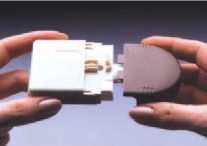
2 Hold the corners of the white tray and pull out gently until you can see all the plastic ridges on the sides of the tray.
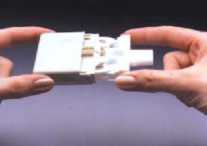
3 Put your finger and thumb on the ridges, squeeze inwards and gently pull the tray out of the body of the Diskhaler.

MHRA Submission: PIQ Article 61(3) submission-update section 4 of PIL under severe allergic reactions, MAH and QRD updates Text Version: 28/01/2013 Text Version: Issue 2 Draft 1
4 Place a Rotadisk on the wheel so that the numbers face upwards and then slide the tray back into the Diskhaler.
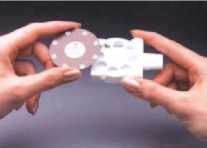
GETTING READY FOR THE FIRST DOSE
5 Hold the corners of the tray as shown in the picture and slide the tray out and in. This will rotate the Rotadisk.
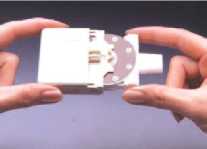
6 Continue until the number '8' appears in the small window. The Rotadisk is now ready for use. As you use each dose the number of doses remaining is shown in the window.

OPENING THE BLISTER TO RELEASE A DOSE
7 Keep the Diskhaler level. Lift up the back of the lid as far as it will go and until it is fully upright. The lid must be raised until fully upright to pierce both the top and bottom of the blister. This will need firm pressure.
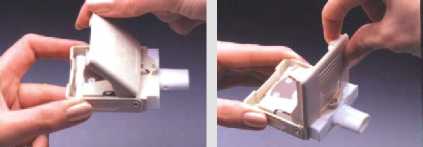
Then close the lid. The Diskhaler is now ready for use.
Do not try to lift the lid until the white sliding tray is pushed fully in or is completely removed e.g. when cleaning the Diskhaler.
INHALING YOUR MEDICINE
8 Breathe out as far as is comfortable.
9 Keep the Diskhaler level and raise it to your mouth. Place the mouthpiece between your teeth and close your lips firmly around it but do not bite it. Do not cover the small air holes on either side of the mouthpiece.
MHRA Submission: PIQ Article 61(3) submission-update section 4 of PIL under severe allergic reactions, MAH and QRD updates Text Version: 28/01/2013 Text Version: Issue 2 Draft 1

10 Suck in through your mouth as quickly and as deeply as you can.
11 Hold your breath and remove the Diskhaler from your mouth. Continue to hold your breath for a few seconds or as long as is comfortable.
GETTING READY FOR THE NEXT DOSE
12 Do not open the blister until you are ready to take the next dose. Turn the Rotadisk to the next number ('7') by gently pulling out the tray and pushing it in once.
When you need to take another dose repeat steps 7 to 12.
Always wipe the mouthpiece with a tissue and replace the cover after use.
REPLACING THE ROTADISK WHEN IT IS EMPTY
13 Each Rotadisk has eight blisters. As you use up each blister, numbers will count
backwards i.e. '8', '7', '6', etc. When the number '8' reappears, the Rotadisk is empty and should be replaced. To take out the old Rotadisk and put in the new one, repeat steps 2 to 4.
CLEANING YOUR DISKHALER
14 There is a brush in the small space under the lid at the rear of the Diskhaler body.
a) Remove the tray from the Diskhaler body.
b) Brush away any powder left behind on the parts of the Diskhaler.
c) Replace the tray and mouthpiece cover.
You may need to replace your Diskhaler after about three months of use.
The Rotadisks with Becodisks should only be used in a Diskhaler.
If you use more Becodisks than you should
If you use more than you should, talk to your doctor as soon as possible.
It is important that you take your dose as stated on the pharmacist’s label or as advised by your doctor. You should not increase or decrease your dose without seeking medical advice.
If you forget to use Becodisks
• Take the next dose when it is due.
• Do not take a double dose to make up for the forgotten dose.
If you stop using Becodisks
• Do not stop treatment even if you feel better unless told to do so by your doctor.
MHRA Submission: PIQ Article 61(3) submission-update section 4 of PIL under severe allergic reactions, MAH and QRD updates Text Version: 28/01/2013 Text Version: Issue 2 Draft 1
If you have any further questions on the use of this product, ask your doctor, nurse or pharmacist.
Possible Side Effects
Like all medicines, Becodisks can cause side effects, although not everybody gets them.
If you notice any of the following serious side effects, stop using this medicine and talk to your doctor straight away. You may need urgent medical treatment.
• allergic reactions (affects less than 1 in 100 people) - the signs include skin rashes, redness, itching or weals like nettle rash or hives
• severe allergic reactions (affects less than 1 in 10,000 people) - the signs include swelling of your eyes, face, lips, mouth, tongue or throat which may cause difficulty in swallowing or breathing, itchy rash, feeling faint and light headed and collapse
• your breathing or wheezing gets worse straight after using your inhaler.
Talk to your doctor as soon as possible if:
• after 7 days of using Becodisks your shortness of breath or wheezing does not get better, or gets worse.
Other side effects include:
Very common (affects more than 1 in 10 people)
• thrush in the mouth and throat
Common (affects less than 1 in 10 people)
• sore tongue or throat
• hoarseness of voice
Problems with your mouth and throat can be reduced by doing certain things straight after inhaling your dose. These are brushing your teeth, rinsing your mouth or gargling with water and spitting it out. Tell your doctor if you have these problems with your mouth or throat, but do not stop treatment unless you are told to.
Very rare (affects less than 1 in 10,000 people)
• sleeping problems or feeling worried, over-excited and irritable. These effects are more likely to occur in children
• the way steroids are produced by your body may be affected when using Becodisks. This is more likely to happen if you use high doses for a long period of time. This can cause:
- children and young people to grow more slowly.
- something called ‘Cushing’s syndrome’. This happens when you have too much steroid in your body and it can cause thinning of your bones and eye problems (such as cataracts and glaucoma).
Your doctor will help stop this happening by making sure you use the lowest dose of steroid which controls your symptoms.
Although the frequency is not known, the following side effects may also occur:
• depression, feeling restless or nervous. These effects are more likely to occur in children.
If any of the side effects gets serious, or if you notice any side effects not listed in this leaflet, please tell your doctor, nurse or pharmacist.
5 How to store Becodisks
• Keep your Becodisks away from direct heat or sunlight.
• Keep out of the sight and reach of children.
• Do not store above 30°C.
• Do not puncture the blister on the Rotadisk™ until you are ready to inhale a dose.
MHRA Submission: PIQ Article 61(3) submission-update section 4 of PIL under severe allergic reactions, MAH and QRD updates Text Version: 28/01/2013 Text Version: Issue 2 Draft 1
• Do not use Becodisks after the expiry date which is stated on the Rotadisk and carton {EXP} .The expiry date refers to the last day of that month.
• Medicines should not be disposed of via wastewater or household waste. Ask your pharmacist how to dispose of medicines no longer required. These measures will help to protect the environment.
• If you are told to stop using this medicine return any unused Rotadisks to your pharmacist to be destroyed.
6 Contents of the pack and other information
What Becodisks contains
• The active substance is beclometasone dipropionate
• The other ingredient is lactose.
What Becodisks looks like and contents of the pack
The Rotadisk contains powder in eight foil blisters around its edge.
Each blister contains 100 micrograms, 200 micrograms or 400 micrograms beclometasone dipropionate, and lactose which acts as the 'carrier'.
The 100, 200 or 400 micrograms Becodisks packs contain fifteen Rotadisks. Becodisks refill packs contain only the Rotadisks and not the Diskhaler.
Marketing Authorisation Holder and Manufacturer
Marketing Authorisation Holder:
Glaxo Wellcome UK Limited Stockley Park West
Uxbridge
Middlesex
UB11 1BT
Manufacturer:
Glaxo Wellcome Productions
Evreux
France.
Other formats:
To listen to or request a copy of this leaflet in Braille, large print or audio please call, free of charge:
0800 198 5000 (UK Only)
Please be ready to give the following information:
Product name Becodisks 100
Becodisks 200 Becodisks 400
Reference numbers 10949/0055, 10949/0056, 10949/0057
This is a service provided by the Royal National Institute of the Blind.
Leaflet date: March 2013
Becodisks, Diskhaler, Rotadisk and Rotadisks are trademarks of the GlaxoSmithKline group of companies.
© 2013 GlaxoSmithKline group of companies
MHRA Submission: PIQ Article 61(3) submission-update section 4 of PIL under severe allergic reactions, MAH and QRD updates Text Version: 28/01/2013 Text Version: Issue 2 Draft 1

ALLEN &.HAN BURYS